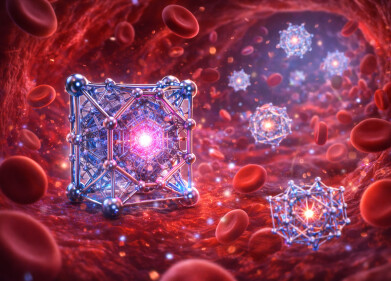-
 Jim Naismith
Jim Naismith -
 STeve Reyntjens
STeve Reyntjens
News
Advancing Structural Biology Research through Automation
Aug 15 2022
Cryo-electron tomography (cryo-ET) provides unprecedented insights into the inner workings of cells, but clear, reliable results depend on high-quality cryo-lamella preparation which is a time-consuming process. The Rosalind Franklin Institute and Thermo Scientific have been working together on development of a system specifically designed for automated, high-throughput production of cryo-lamellae from vitrified cells. The Arctis Cryo-Plasma Focused Ion Beam (Cryo-PFIB) offers a direct connection between cryo-FIB-SEM sample preparation and cryo-transmission electron microscopy (cryo-TEM) within the tomography workflow.
Jim Naismith, Director of The Rosalind Franklin Institute and Steve Reyntjens, Product Marketing Director Life Science, at Thermo Fisher’s Eindhoven facility explained some of the reasons behind their joint development of the cryo-PFIB system to International Labmate.
What void is the Arctis (cryo-PFIB) intending to fill?
"Cryo-electron tomography (cryo-ET) makes it possible to study how proteins and other molecules operate together in a cellular context, at resolutions unsurpassed by other microscopy techniques and has enormous potential for cell biology research, including the study of infectious disease, neurodegenerative disease and other globally impactful structural biology applications. However, the process of preparing optimal samples for cryo-ET is still time-consuming and complex
"Understanding the need to tackle these challenges in order to advance the pace of structural biology research, we at Thermo Fisher Scientific joined forces with The Rosalind Franklin Institute to understand and determine what’s next for cryo-EM. More specifically, in seeing how quickly cryo-ET was proving valuable for better understanding of cellular function and unraveling longstanding mysteries across the study of disease and other life sciences applications, we decided to pursue the development of new plasma-FIB technologies and automated cryo-ET workflows," said Steve Reyntjens .
Q: What scientific research provided the foundation for the experimental methods and engineering behind approaching development of Arctis?
“There is such an urgent need for the Arctis Cryo-PFIB because before its creation, the milling of lamellae was time consuming and often failed,” said Jim Naismith, director of The Rosalind Franklin Institute and collaborator in the development of the Thermo Scientific Arctis Cryo-PFIB.
“The beauty of the samples we work with is that they’re native and not chemically modified, stained or fixed, though this means they have to be thinned. What we really needed was a machine that would simplify this task so that we can get many more lamellae measured. Because it's a numbers game; the more lamellae that you can measure, the better insights you will gain, but those lamellae have to be of the right quality. That’s now come into being with the Arctis, a brand-new plasma-FIB which is a highly automated and powerful machine that will simplify the workflow for groups around the world.”
“The Arctis Cryo-PFIB has a number of special features, including an Autoloader from Thermo Fisher, which takes samples in and out of the machine and is essentially fully automated. Another notable feature is that the chamber is smaller and as a result, the vacuum is much better, therefore samples that come out are pristine and not covered in ice or contamination. Additionally, the software on the machine allows us to run an automated, unsupervised workflow, which is crucial to what we aim to do here at The Rosalind Franklin Institute.
“We strive to provide end-to-end cryo-EM workflow solutions for new and experienced users. Our goal with expanding our automation capabilities to our cryo-PFIB portfolio is to help scientists pave the way for cryo-ET to become a frontier technique for cell biology.
This work at The Rosalind Franklin Institute falls under its Electrifying Life Science initiative.
More information online
Digital Edition
Lab Asia Dec 2025
December 2025
Chromatography Articles- Cutting-edge sample preparation tools help laboratories to stay ahead of the curveMass Spectrometry & Spectroscopy Articles- Unlocking the complexity of metabolomics: Pushi...
View all digital editions
Events
Jan 21 2026 Tokyo, Japan
Jan 28 2026 Tokyo, Japan
Jan 29 2026 New Delhi, India
Feb 07 2026 Boston, MA, USA
Asia Pharma Expo/Asia Lab Expo
Feb 12 2026 Dhaka, Bangladesh


















